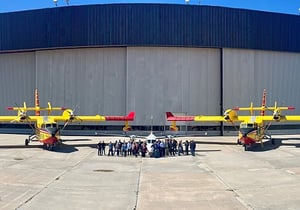Zephyr Energy plc (LON:ZPHR) is the topic of conversation when Auctus Advisors’ Head of Research Stephane Foucard caught up with DirectorsTalk for an exclusive interview.
Q1: Could you just tell us what the story is with Zephyr Energy?
A1: It’s really a turnaround story. It’s a company that focussed on the US onshore but there has been for various reasons broadly ignored by the general market and the institutional investors.
The company has been around for a number of years under different names but until recently, it had a very unfocussed changing strategy with assets across multiple commodity, multiple geographic, very scattered. I was only in 2019 when a US oil and gas specialist investor saw a raw diamond in the company portfolio and basically took control of the company and that’s where things finally changed.
We had a few divestment of assets, small M&A and that turned the company into a business solely focussed on oil and gas in the Rocky Mountains.
And of course, in 2020 when COVID hit and all those changes I think went unnoticed until the fast few months when the company reported very good results at the drill bed.
Fast forward to today, the company have produced about 1,600 barrels a day of highly profitable production in the Bakken in the U.S. but the prize asset is a very high impact multi 100 million barrels asset in the Paradox Basin in Utah. That’s where the company have actually cracked the code in what could become one of the last untapped unconventional basin in the U.S.
Q2: What is it that makes the Paradox Basin so exciting do you think?
A2: It’s located across the states of Utah and Colorado. It’s not a new basin as such, it’s actually well known but the industry so far has made a lot of large discoveries at historical 30/40/50 years ago in the deeper conventional part of the basin.
The northern part where the company has its asset is much less conventional and it adds quite mixed results historically and this is because what is being targeted in this play is effectively looking for natural fracture in the reservoir. When you drill, if you hit the fracture, you have good well results but often you don’t hit them, in which case the result of drilling are not so good so it really has been hit and miss.
Because it is not the typical straightforward unconventional basin, because basically you can pull naturally from the frack without fracking, it has been overlooked by the industry during the frack boom that we saw in the U.S. So, it means that modern technology were not really applied to that basin, there’s been no fracking, it has been ignored.
The idea of Zephyr is to bring 3D seismic model that is being used in the big, larger commercial basins in the U.S., it is about bringing fracking technology and completion technology to the Paradox Basin.
The idea is that with 3D seismic, you’ll be able to see the sweet spot so you can optimise where you drill, you would have better flow rates and importantly, you would be able to get systematic results. So far, this has worked very very well.
Q3: So, they’ve brought all of this technology in, what have the company so far in the Paradox Basin?
A3: The drilling results have highlighted nine oil bearing zones that could accommodate fracking and a few months, the company drilled its first horizontal multistage frack targeting just the deeper sands, it’s called Cane Creek, that was a couple of months ago. The well delivered results and flow rates widely beyond what was expected, actually the company now expect that this well could be put into production north of 2,000 barrel, talking of stable production with initial minimum decline.
Importantly, the results were achieved without any hitting any of the big frack that was required in the past to make the well work. So, the success suggests that the company’s theory was actually correct and that could demonstrate the possibility of consistent development of the basin with predictable drilling results.
Just from those results, from these bottom sands, they were already able to get a few million barrels just around the well and de-risked 30 million contingent resources within that sands.
So, the next step is ready to scale-up, it’s about developing that deeper sand and de-risk all of the 8 upper sands. Each sands holds about 25-30 million barrels so overall it’s north of 200 million barrels that the company could have, each sand produces 4,000-5,000 barrels a day so multiply by 8, that’s quite a lot. Each sands delivers, once in production, $25 million to $30 million of free cash flow per year per sand and that’s in the context of the market cap of the company which is basically just $90 million so it’s very exciting.
Q4: What can you tell us about the Bakken assets?
A4: The company has two assets, I talked about the prized which is the Paradox Basin and the Bakken asset is where its production is currently coming from.
They acquired multiple non-operated small assets across the Williston Basin, they have about 4 million barrels 2P reserve, and those were acquired from a larger company that faced capital discipline pressure from their shareholders so basically, they were bought on the cheap.
The way those assets create value is basically four avenues of value. First, obviously, they were bought on the cheap, they were bought at a time when prices were much lower than today. The latest asset they bought, they paid $36 million, it’s probably worth today $75 million.
Second, they give cash flow to the company and production, it means typically you are able to attract different sorts of investors that want cash flow and hopefully that therefore helps the share price.
Three, the production and the cash flow from the Williston Basin is basically funded the high impact activity in the Paradox.
Lastly, it provides diversification from the two basins from which the company is producing.
On top of that, there will be some knowledge transfer because everything which is being applied in the Bakken could be used in the Paradox.
Q5: Just looking forward, what’s next for Zephyr Energy?
A5: The company is about the embark on a 3-well drilling campaign starting probably in the second half of this year and those 3 wells which are in the Paradox have effectively three goals:
- To grow production so we’re talking potentially 4,000 barrels per day of oil by the end of the fourth quarter of next year,
- That might move the company, on success to start booking the 30 million barrel of contingent resources from the deeper basin that I talked about,
- One of the well is targeting one of the upper sands so they are starting going after the big upside in the shallower sand in the Paradox.




































